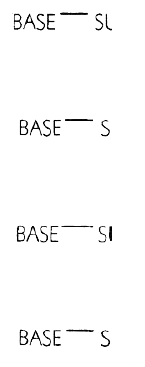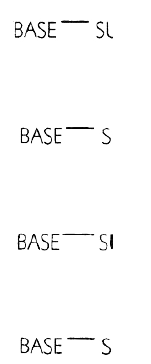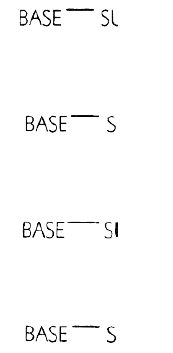In a charged transfer RNA, the nucleotide bound to the amino acid is adenosine (A) and the next two nucleotides are cytosines (C). What can you tell about the DNA codon to which this transfer RNA corresponds?
The codon is TGG
The codon is ACC
The first position is A, but you can't tell about the other from the information given
You can't tell anything about the codon from the information given.
The correct Answer is:D
Step by step video, text & image solution for In a charged transfer RNA, the nucleotide bound to the amino acid is adenosine (A) and the next two nucleotides are cytosines (C). What can you tell about the DNA codon to which this transfer RNA corresponds? by Biology experts to help you in doubts & scoring excellent marks in Class 12 exams.
Updated on:21/07/2023Topper's Solved these Questions
Similar Questions
Information about protein synthesis is stored in the DNA. Proteins are synthesized by DNA through RNA. This is also known as the central dogma of life. The nucleotide sequences of the mRNA produced are complementary to the DNA strand that is uded as the template for synthesis. This process of synthesis of RNA from DNA is known as transcription. The code for each amino acid consists of three nucleotides (triplet codon) that are present on the mRNA. The tRNA has an anticodon sequence complementary to the cofon on the mRNA. During translation, the code on mRNA is read nad respective amino acids brought by tRNA are joined together by peptide bonds. Based on the given paragraph, answer the followig question:
i. If 3'-AACGT-5' is a sequence of the template DNA strand, what would be the nucleotide sequence of the corresponding mRNA synthesized from it?
ii. What is the difference in nitrogeneous bases of DNA and RNA?
iii. Which enzyme woud be required for the synthesis of RNA from DNA during transcription?
iv. How many amino acids can the following mRNA sequence code for ?
5'-UUCAGCCGUGUCAUU-3'
v. What is the function of mRNA in translation?
View SolutionObserve the following messenger RNA :

Due to a mutation , the guanine nucleotide in the sixth position is replaced by an adenine nucleotide. What will be the correct effect on the sequence of amino acids due to this mutation ?
View Solution
Knowledge Check
Which of these statements about protein synthesis are NOT correct ?
I. During transcription, mRNA synthesized from DNA nucleotides to have the same sequence of nucleotides as the DNA strand on which it was made.
II. During transcription , tRNA is synthesized from RNA nucleotides and carries codons that are complementary to the sequence of nucleotides on the DNA strand on which it was made.
III. During translation, mRNA is synthesized from RNA nucleotides to have the complementary sequence of nucleotides to that. Of the DNA strand on which it was made .
IV. During translation ribosomes move on mRNA from '5' and '3' one codon at a time .This is called translocationAI,II and III onlyBI,II ,III and IVCIII and IV onlyDI, II and IV onlyOxygen-rich blood from the lungs comes to the thin-walled upper chamber of the heart on the left. The left upper chamber (A) then relaxes. It then contracts and the blood is allowed to enter the next chamber (B), as it expands. When the muscular left lower chamber of heart contracts the blood is pumped out to the body via aorta.
Deoxygenated blood reaches from the body to the upper chamber on the right side of heart (C) and it expands. As this part contracts, the corresponding lower chamber (D) dilates. This transfers the blood to right ventricle, which in turn pumps it to the lungs for oxygenated.
What prevents backflow of blood inside the heart during contraction?AValves in heartBThick muscular walls of ventriclesCThin walls of atriaDAll of the aboveOxygen-rich blood from the lungs comes to the thin-walled upper chamber of the heart on the left. The left upper chamber (A) then relaxes. It then contracts and the blood is allowed to enter the next chamber (B), as it expands. When the muscular left lower chamber of heart contracts the blood is pumped out to the body via aorta.
Deoxygenated blood reaches from the body to the upper chamber on the right side of heart (C) and it expands. As this part contracts, the corresponding lower chamber (D) dilates. This transfers the blood to right ventricle, which in turn pumps it to the lungs for oxygenated.
What is the correct route of blood in a human?AA → B → Lungs → C → DBA → B → D → C → LungsCC → D → B → A → LungsDC → D → Lung → A → B
Nucleic acids are the biopolymers in which the repeating structural monomeric units is a nucleotide. The nucleotides structural monomeric unit is a nucleotide. The nucleotides consist of three components, a pentose sugar (D−(0)− ribose or 2 - deoxy −D−(−)−ribose, heterocyclic base), (purines i.e., adenine and guanine and pyrididines i.e., thymine, cytosine and uracil) and phosphoric acid. Sugar - base constitutes nucleosides. the two types of nucleic acids are DNA and RNA. Nucleic acids play significant role in replication and protein synthesis.
Name the base which is present in RNA but not in DNA.
View SolutionRead the passage given below and answer the question:
EVIDENCE FOR THE FIBROUS NATURE OF DNA
The basic chemical formula of DNA is now well established. As shown in Figure 1 it consists of a very long chain, the backbone of which is made up of alternate sugar and phosphate groups, joined together in regular 3' 5' phosphate di-ester linkages. To each sugar is attached a nitrogenous base, only four different kinds of which are commonly found in DNA. Two of these---adenine and guanine--- are purines, and the other two thymine and cytosine-are pyrimidines. A fifth base, 5-methyl cytosine, occurs in smaller amounts in certain organisms, and a sixth, 5-hydroxy-methyl-cytosine, is found instead of cytosine in the T even phages. It should be noted that the chain is unbranched, a consequence of the regular internucleotide linkage. On the other hand the sequence of the different nucleotides is, as far as can be ascertained, completely irregular. Thus, DNA has some features which are regular, and some which are irregular. A similar conception of the DNA molecule as a long thin fiber is obtained from physicochemical analysis involving sedimentation, diffusion, light scattering, and viscosity measurements. These techniques indicate that DNA is a very asymmetrical structure approximately 20 A wide and many thousands of angstroms long. Estimates of its molecular weight currently center between 5×106 and 107 (approximately 3×104 nucleotides). Surprisingly each of these measurements tend to suggest that the DNA is relatively rigid, a puzzling finding in view of the large number of single bonds (5 per nucleotide) in the phosphate-sugar back bone. Recently these indirect inferences have been confirmed by electron microscopy.

(source: Watson, J. D., & Crick, F.H. (1953, January). The structure of DNA. In Cold Spring Harbor symposia on quantitative biology (Vol. 18, pp. 123-131). Cold Spring Harbor Laboratory Press.)
DNA molecule has _______ internucleotide linkage and ______ sequence of the different nucleotides
View SolutionRead the passage given below and answer the question:
EVIDENCE FOR THE FIBROUS NATURE OF DNA
The basic chemical formula of DNA is now well established. As shown in Figure 1 it consists of a very long chain, the backbone of which is made up of alternate sugar and phosphate groups, joined together in regular 3' 5' phosphate di-ester linkages. To each sugar is attached a nitrogenous base, only four different kinds of which are commonly found in DNA. Two of these---adenine and guanine--- are purines, and the other two thymine and cytosine-are pyrimidines. A fifth base, 5-methyl cytosine, occurs in smaller amounts in certain organisms, and a sixth, 5-hydroxy-methyl-cytosine, is found instead of cytosine in the T even phages. It should be noted that the chain is unbranched, a consequence of the regular internucleotide linkage. On the other hand the sequence of the different nucleotides is, as far as can be ascertained, completely irregular. Thus, DNA has some features which are regular, and some which are irregular. A similar conception of the DNA molecule as a long thin fiber is obtained from physicochemical analysis involving sedimentation, diffusion, light scattering, and viscosity measurements. These techniques indicate that DNA is a very asymmetrical structure approximately 20 A wide and many thousands of angstroms long. Estimates of its molecular weight currently center between 5×106 and 107 (approximately 3×104 nucleotides). Surprisingly each of these measurements tend to suggest that the DNA is relatively rigid, a puzzling finding in view of the large number of single bonds (5 per nucleotide) in the phosphate-sugar back bone. Recently these indirect inferences have been confirmed by electron microscopy.

(source: Watson, J. D., & Crick, F.H. (1953, January). The structure of DNA. In Cold Spring Harbor symposia on quantitative biology (Vol. 18, pp. 123-131). Cold Spring Harbor Laboratory Press.)
Out of the four different kinds of nitrogenous bases which are commonly found in DNA, _______ has been replaced in some organisms.
View SolutionRead the passage given below and answer the question:
EVIDENCE FOR THE FIBROUS NATURE OF DNA
The basic chemical formula of DNA is now well established. As shown in Figure 1 it consists of a very long chain, the backbone of which is made up of alternate sugar and phosphate groups, joined together in regular 3' 5' phosphate di-ester linkages. To each sugar is attached a nitrogenous base, only four different kinds of which are commonly found in DNA. Two of these---adenine and guanine--- are purines, and the other two thymine and cytosine-are pyrimidines. A fifth base, 5-methyl cytosine, occurs in smaller amounts in certain organisms, and a sixth, 5-hydroxy-methyl-cytosine, is found instead of cytosine in the T even phages. It should be noted that the chain is unbranched, a consequence of the regular internucleotide linkage. On the other hand the sequence of the different nucleotides is, as far as can be ascertained, completely irregular. Thus, DNA has some features which are regular, and some which are irregular. A similar conception of the DNA molecule as a long thin fiber is obtained from physicochemical analysis involving sedimentation, diffusion, light scattering, and viscosity measurements. These techniques indicate that DNA is a very asymmetrical structure approximately 20 A wide and many thousands of angstroms long. Estimates of its molecular weight currently center between 5×106 and 107 (approximately 3×104 nucleotides). Surprisingly each of these measurements tend to suggest that the DNA is relatively rigid, a puzzling finding in view of the large number of single bonds (5 per nucleotide) in the phosphate-sugar back bone. Recently these indirect inferences have been confirmed by electron microscopy.

(source: Watson, J. D., & Crick, F.H. (1953, January). The structure of DNA. In Cold Spring Harbor symposia on quantitative biology (Vol. 18, pp. 123-131). Cold Spring Harbor Laboratory Press.)
DNA has a _______ backbone
View SolutionRead the passage given below and answer the question:
EVIDENCE FOR THE FIBROUS NATURE OF DNA
The basic chemical formula of DNA is now well established. As shown in Figure 1 it consists of a very long chain, the backbone of which is made up of alternate sugar and phosphate groups, joined together in regular 3' 5' phosphate di-ester linkages. To each sugar is attached a nitrogenous base, only four different kinds of which are commonly found in DNA. Two of these---adenine and guanine--- are purines, and the other two thymine and cytosine-are pyrimidines. A fifth base, 5-methyl cytosine, occurs in smaller amounts in certain organisms, and a sixth, 5-hydroxy-methyl-cytosine, is found instead of cytosine in the T even phages. It should be noted that the chain is unbranched, a consequence of the regular internucleotide linkage. On the other hand the sequence of the different nucleotides is, as far as can be ascertained, completely irregular. Thus, DNA has some features which are regular, and some which are irregular. A similar conception of the DNA molecule as a long thin fiber is obtained from physicochemical analysis involving sedimentation, diffusion, light scattering, and viscosity measurements. These techniques indicate that DNA is a very asymmetrical structure approximately 20 A wide and many thousands of angstroms long. Estimates of its molecular weight currently center between 5×106 and 107 (approximately 3×104 nucleotides). Surprisingly each of these measurements tend to suggest that the DNA is relatively rigid, a puzzling finding in view of the large number of single bonds (5 per nucleotide) in the phosphate-sugar back bone. Recently these indirect inferences have been confirmed by electron microscopy.

(source: Watson, J. D., & Crick, F.H. (1953, January). The structure of DNA. In Cold Spring Harbor symposia on quantitative biology (Vol. 18, pp. 123-131). Cold Spring Harbor Laboratory Press.)
Purines present in DNA are:
View Solution
